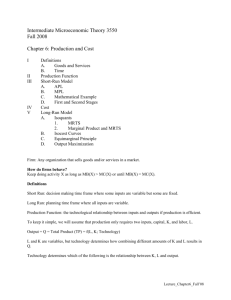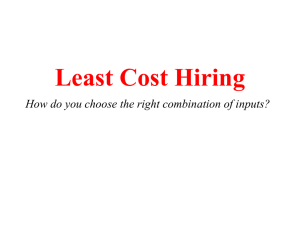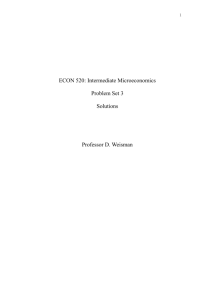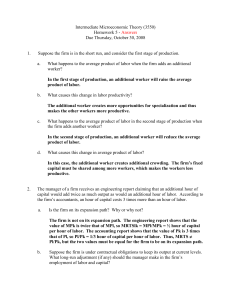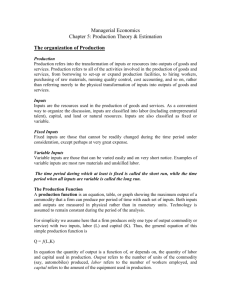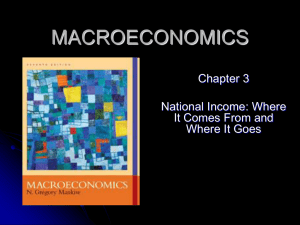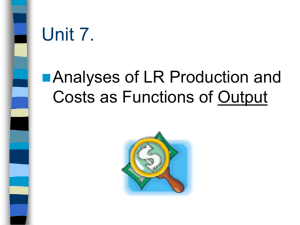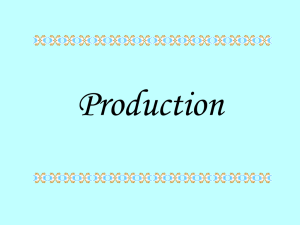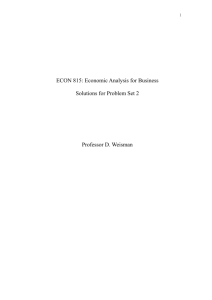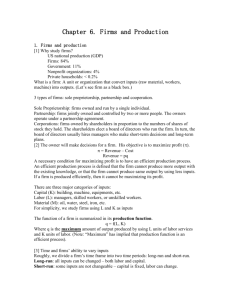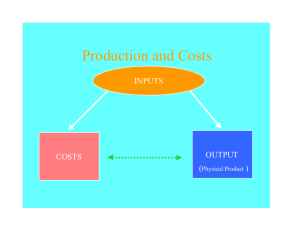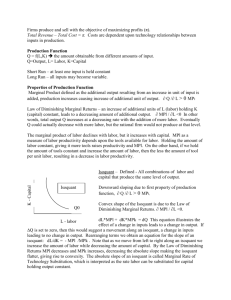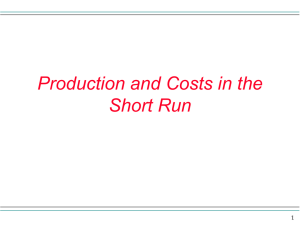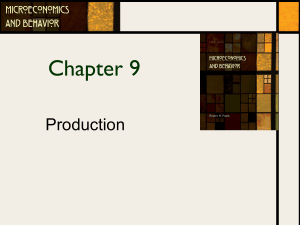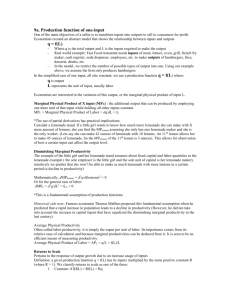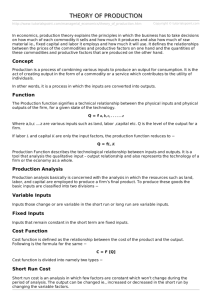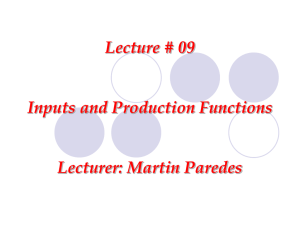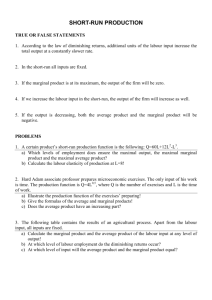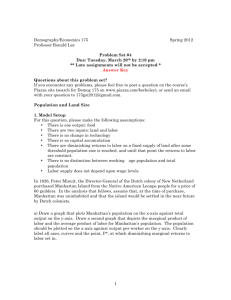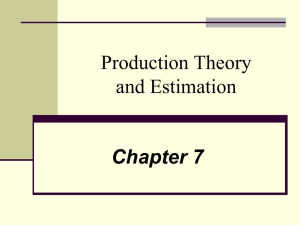Economics of the firm - Cal State LA
advertisement
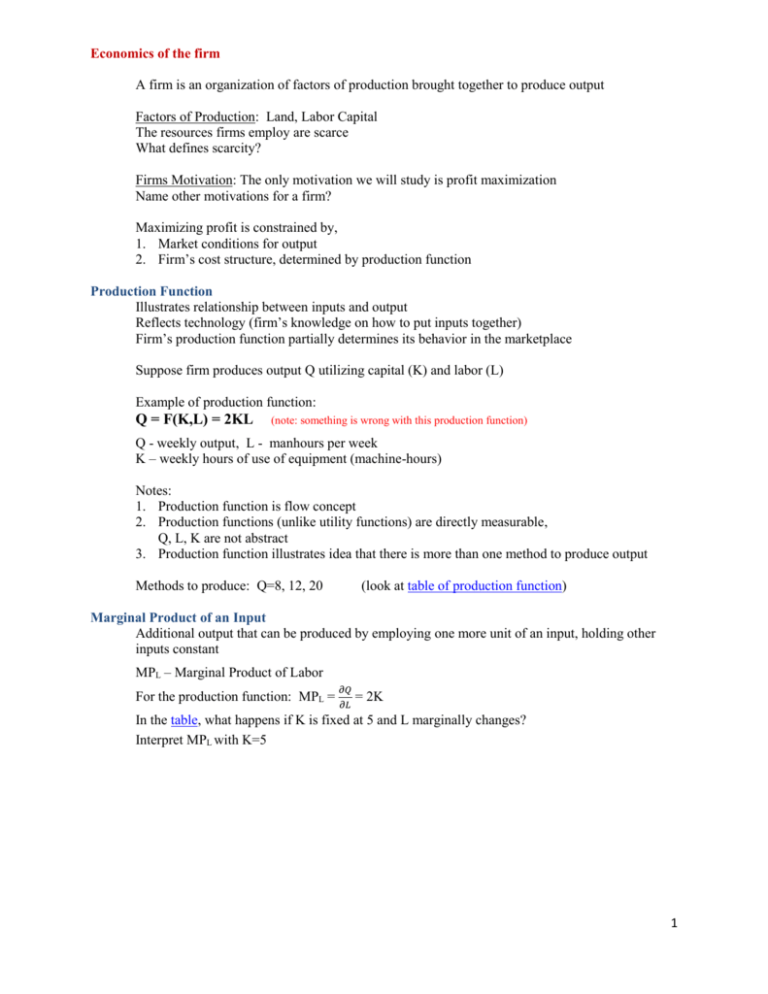
Economics of the firm A firm is an organization of factors of production brought together to produce output Factors of Production: Land, Labor Capital The resources firms employ are scarce What defines scarcity? Firms Motivation: The only motivation we will study is profit maximization Name other motivations for a firm? Maximizing profit is constrained by, 1. Market conditions for output 2. Firm’s cost structure, determined by production function Production Function Illustrates relationship between inputs and output Reflects technology (firm’s knowledge on how to put inputs together) Firm’s production function partially determines its behavior in the marketplace Suppose firm produces output Q utilizing capital (K) and labor (L) Example of production function: Q = F(K,L) = 2KL (note: something is wrong with this production function) Q - weekly output, L - manhours per week K – weekly hours of use of equipment (machine-hours) Notes: 1. Production function is flow concept 2. Production functions (unlike utility functions) are directly measurable, Q, L, K are not abstract 3. Production function illustrates idea that there is more than one method to produce output Methods to produce: Q=8, 12, 20 (look at table of production function) Marginal Product of an Input Additional output that can be produced by employing one more unit of an input, holding other inputs constant MPL – Marginal Product of Labor For the production function: MPL = 𝜕𝑄 𝜕𝐿 = 2K In the table, what happens if K is fixed at 5 and L marginally changes? Interpret MPL with K=5 1 Law of Diminishing Returns Other inputs held constant, the productivity of the variable input must eventually begin to diminish (examples: flower pot, CSULA) Short run concept More realistic production function: Q = F(K,L) = K1/2L1/2 MPL = 𝜕𝐹(𝐾,𝐿) 1 𝐾 =1/2K1/2L-1/2= 2 √ 𝐿 𝜕𝐿 MPK = 𝜕𝐹(𝐾,𝐿) 1 𝐿 =1/2K-1/2L1/2= 2 √𝐾 𝜕𝐾 Relate calculated MPK and MPL to law of diminishing returns: 𝜕𝑀𝑃𝐿 𝜕𝐿 = -1/4 K1/2L-3/2 < 0 MPL continuously diminishes with L, but MPL itself is always positive The same can be said for MPK MPL L (interpret 𝜕𝑀𝑃𝐿 𝜕𝐾 and 𝜕𝑀𝑃𝐾 )q 𝜕𝐿 Productivity is commonly used to refer to average product APL – Average Product of Labor APL = 𝑄 𝐿 Production Function: F(K,L) = K1/2L1/2 APL = 𝐾1/2 𝐿 1/2 𝐿 𝐾 = √𝐿 For our production function, average product is twice the marginal product. Diagram of total and marginal product. 2 With Production Function: F(K,L) = K1/2L1/2, identify ways firm can produce Q=10 Point K L 1 100 5 20 B 10 10 20 5 A 25 4 100 1 Isoquant – set of input combinations that yield a given level of output Capital 20 A 10 B 5 Q’ Q10 5 10 20 Labor Output held constant along isoquant Firm may produce Q=10 at any point along Q10 isoquant The input mix the firm chooses will depend on relative input prices (What is output level of Q’?) Marginal Rate of Technical Substitution: Rate at which firm can substitute between inputs, holding output constant It is the slope of the isoquant MRTSL,K = −∆𝐾 𝑀𝑃 | = 𝐿 ∆𝐿 𝑄0 𝑀𝑃𝐾 [derive by taking total differential] MRTSL,K is a function of input marginal products MRTSL,K normally diminishes as move down isoquant For our production function: MRTSL,K = 𝑀𝑃𝐿 𝑀𝑃𝐾 1/2𝐾1/2 𝐿 −1/2 = 1/2𝐾−1/2 𝐿1/2 = 𝐾 𝐿 = 4 at point A = ¼ at point B (interpret) Point A: firm producing output with relatively large amount of capital; easier to forego capital for labor (example: teaching with technology) 𝜕𝑀𝑅𝑇𝑆𝐿,𝐾 𝜕𝐿 = −𝐾 𝐿2 < 0 which indicates diminishing MRTS as move down isoquant (L getting larger) 3 Returns to Scale What happens to relationship between inputs and outputs when the scale of operation changes? Long run concept Increasing Returns Proportional increase in all inputs yields a more than proportional increase in output Constant Returns Proportional increase in all inputs increases output by an equal proportion Decreasing Returns Proportional increase in all inputs yields a less than proportional increase in output Production Function: Q = F(K,L) = K1/2L1/2 Suppose K and L increase by common factor (by 2 for example) F(2K,2L) = (2K)1/2(2L)1/2 = 21/2 · 21/2 K1/2L1/2 = 2 K1/2L1/2 =2Q Doubling both inputs doubles output - Constant Returns What are the returns to scale for these functions? Q=K3/4L1/2 Q=K1/3L1/2 Reasons for increasing returns: division of labor, resources etc. Reasons for decreasing returns: managerial oversight What is difference between law of diminishing returns and the concept of decreasing returns to scale? Problems on opportunity cost 4
